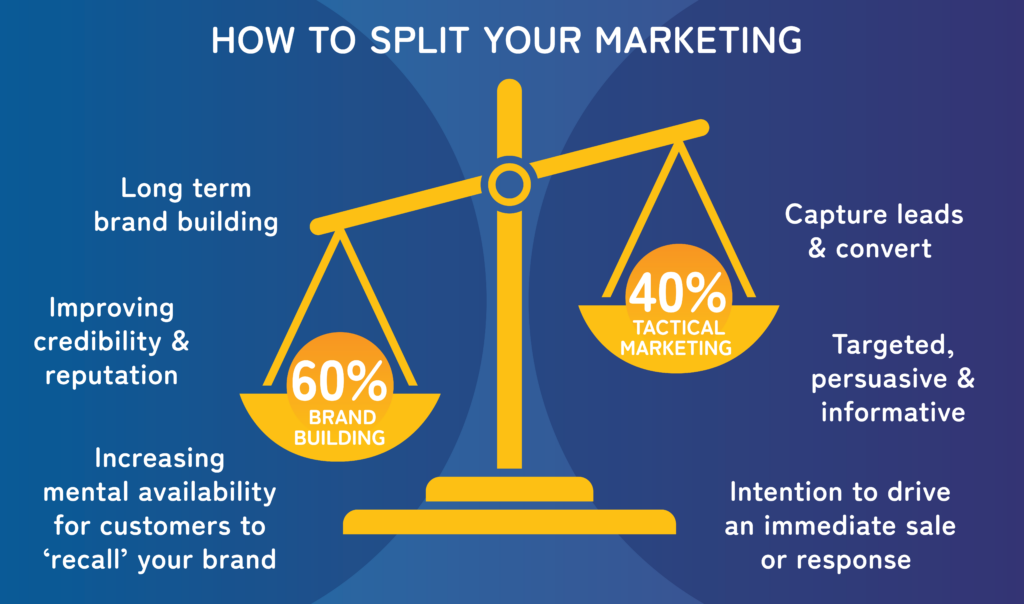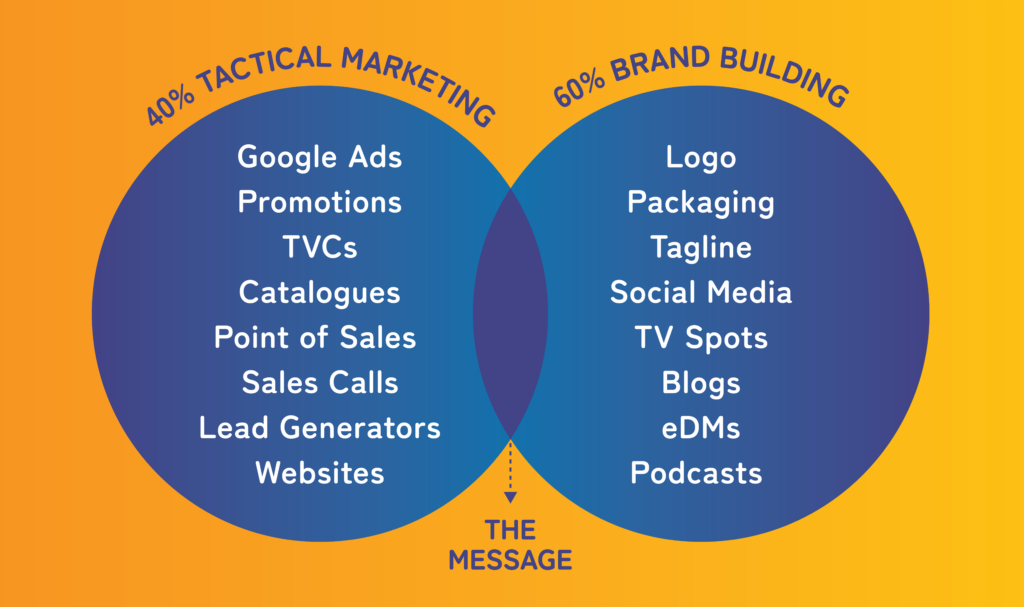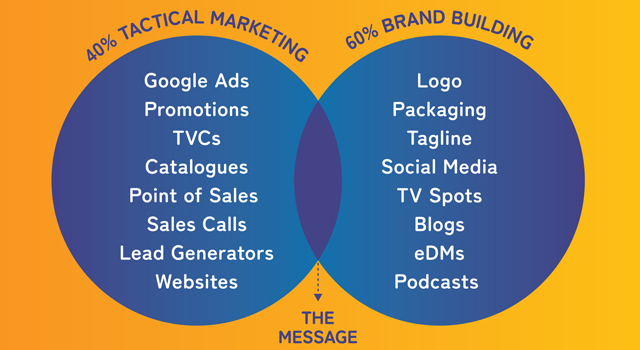Finding the Perfect Balance: Is the 60:40 Brand vs Marketing Split Still Relevant?
There’s a fine line that businesses tend to dance around when it comes to the balance of brand vs tactical marketing investment. There’s no doubt that every business will have an individual approach when it comes to this, proving that you can’t compare apples with other apples. In this opinion piece, we revisit the 60:40 approach to marketing investment and assess its continued relevance to modern media planning and consumer marketing strategies.
What is The 60:40 Brand vs Marketing Split?
The 60:40 split originated from a theory proposed by Les Benit and Peter Field in their 2013 publication “The Long and Short of It”, via the Institute of Practitioners in Advertising (IPA). The study, based on over 1,000 case studies, found that there were two distinct types of advertising, long advertising (brand building) and short advertising (tactical or sales driven activations). Working in very different ways, they further identified in the study that the optimal balance of investment towards these two approaches is 60:40 – 60% brand building and 40% tactical marketing. Since the publishing of this work, it’s now widely considered the equilibrium in the world of advertising.

Long Brand Building Marketing:
Short Tactical Sales Activation:

Balancing Brand vs Tactical Marketing
Too much focus on brand, and you’ll lose out on short term sales revenue, because consumers aren’t being further persuaded down the purchase funnel. Too much focus on direct marketing and you’ll find yourself converting less consumers to customers as they don’t recall your brand when in market.
Any business can claim to have the best product offering in the world and a sensational marketing campaign. However, with increasing competition in today’s market, if a consumer doesn’t recall your brand in the moments that matter (often referred to as CEPs – Category Entry Points), all your marketing efforts are next to futile.
Is the Brand vs Tactical Spilt Still Relevant?
In short, yes. However, as subsequent work by Binet & Field noted, variables such as brand or category maturity, should be taken into consideration and will affect which split is optimal. In the current climate defined by the high cost-of-living and reduced consumer spending, the brand and tactical marketing ratio is more often than not switched to 40:60 as brands seek to stimulate more short term revenue. Is this the right strategy?
At MM we recognise that theory must always be tempered with realism and effective strategies that sustain overall business confidence. Moving to increase the investment ratio into short tactics during challenging economic climates helps secure base revenue and weather the storm so often felt in marketing departments. The critical factor is to avoid removing or redirecting all long term brand investment, as is often the inclination. Doing this has significant long term implications, so the relevance of the 60:40 is less about keeping strictly to figures within a ratio, and more to acknowledge that a ratio must exist. Rely on short term sales tactics alone, and risk your future success completely.
The Retail Sector and the 60:40 Ratio
The retail industry has always been a battlefield for advertisers and marketing teams who are measured more heavily by short term sales results. So how realistic or relevant is this theory for brands in this sector?
Research from the Data & Marketing Association (DMA) over a period of 6 years found that a majority of retailers have increasingly been striking an even balance between brand and tactical marketing activity. Whilst not attaining the theoretical goal of 60:40, a 50:50 approach itself still shows that retailers see the benefits of maintaining long term branding. However, for brands with limited marketing budgets, the ability to justify brand investment while meeting business sales revenue targets remains a constant challenge, particularly as household spending has contracted significantly over recent months.
Retail Marketers Should Fight for Effective Long Brand Strategy Investment
Even if at a much smaller ratio, marketers within the retailer category should always be fighting to maintain a share of investment that speaks to long term branding. At MM, we are here to work with our clients to support and justify this within a healthy overall channel plan. Maximising our consumer intelligence libraries and software to ensure each dollar is invested into brand or tactical by the most effective means possible, whilst negotiating aggressively in softer ad markets, to deliver nuanced creative that will serve short and long term needs.
Our approach to Brand vs Tactical Marketing
At MM, we work with clients to curate a tailor-made strategy that’s unique to their needs and goals, ensuring the ideal balance of increased lead generation and success as well as long-term customer loyalty. Our strongly-held values of Inspire. Connect. are underpinned by a recognition of the vital roles brand and tactical messaging play in a modern advertising landscape. To inspire speaks to the branding intention – raising brand mental availability and preference. Connect refers to the techniques and strategies of tactical marketing to create reasons for consumers to immediately engage with brands and businesses, and deliver short term actions.

Final Thoughts
The research and thinking behind the 60:40 marketing split proposed by Les Benit and Peter Field back in 2013 cannot be discounted. The importance of mental availability and brand recall in the long term success of a brand has been shown countless times. Fast-forward 11 years and in an ever-evolving market, our view however, is that the umbrella approach provided by the 60:40 split should be considered on a case by case basis.
The 60:40 ratio is the north star benchmark for marketing investment, and adopted by many advertisers. But rather than focusing on a defined figure, we seek to champion the importance of Benit & Fields work in proving that including long term brand messaging within any level of marketing investment is critical. From that understanding, it’s our role at MM to support our clients in cultivating the right balance and path forward within their marketing ecosystem. Applying our rigor and ingenuity into understanding and strategically navigating a client’s distinct category position has shown to be as critical to success as defining an optimal investment ratio.








